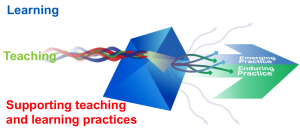As I started working on my proposal for the Canadian Society for the Study of Education (CSSE) 2016 I thought I might try to update some of the references.  I remembered that I had bought Teaching Crowds: Learning and Social Media (Dron & Anderson, 2014) at CSSE in June 2015 where I presented three times and haven’t blogged about at all! …so I cracked it open. I was immediately sucked in…particularly by its promise of providing practical advice to educators, but also by its grounding in theoretical perspectives on learning.
I remembered that I had bought Teaching Crowds: Learning and Social Media (Dron & Anderson, 2014) at CSSE in June 2015 where I presented three times and haven’t blogged about at all! …so I cracked it open. I was immediately sucked in…particularly by its promise of providing practical advice to educators, but also by its grounding in theoretical perspectives on learning.
The first thing to note about this text is that it is available for free at teachingcrowds.ca. You can download the whole book or individual chapters – although I’m enjoying my old-school hard copy.
The second thing that is interesting is the authors’ broad definition of what encompasses social software. They describe social software as software that supports four types of interactions: one-to-one; one-to-many; many-to-many; and many-to-one. The first three are familiar to most, but considering Google Search as a social software which aggregates the preferences of many to represent information to an individual is a perspective that is not usually embraced in literature around social media and learning. However the authors contend that there is learning potential in each and every connection. The book provides an extensive list of types of social software and the types of interactions that can be facilitated by them.
A significant portion of the first chapter is dedicated to outlining the value of social software, but without much theoretical or empirical support. Presumably many of these points will be elaborated on later in the book. However, I think the list has immense value and I am going to repeat it here:
Social software:
- helps build communities;
- helps create knowledge;
- engages, motivates, and is enjoyable;
- is cost-effective;
- encourages active learning;
- is accountable and transparent;
- spans the gap between formal and informal learning;
- addresses both individual and social needs;
- builds identity, expertise, and social capital;
- is easy to use;
- is accessible;
- protects and advances current models of ownership and identity;
- is persistent and findable;
- supports multiple media formats;
- encourages debate, cognitive conflict, and discussion;
- leads to emergence;
- is soft;
- supports creativity;
- expands the adjacent possible.
I think that complexity thinking has a lot to offer in terms of providing support for many of these claims as positive aspects of social software for learning. I am particularly interested in the points that I have put in bold and will be combing the rest of the book for support for these claims. I wish that the authors had also listed some of the challenges or limits of social software to provide a bit more of a balanced view. Things such as the rapid pace of change, and the huge volume of information or data are things that come to mind. However, the authors do note that the last chapter is dedicated to a discussion of issues and challenges.



